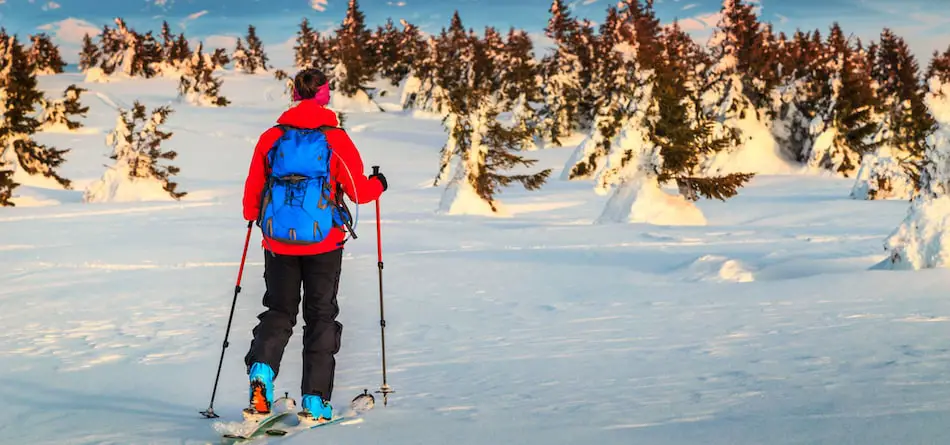
Having the right gear for back country skiing is important. I wrote the following guide to teach a little bit about alpine touring boots.
So, what are alpine touring boots? Alpine Touring boots are a hybrid boot that allow for greater flexibility and movement than traditional ski boots do. AT boots are a cross between a ski boot and a mountaineering boot.
Designed for long, uphill grinds while wearing skis, alpine touring boots are a more flexible take on a traditional ski boot. Made out of materials like carbon fiber and designed to allow flexing of the ankle and upper leg, alpine touring boots are a lot more comfortable to walk in that downhill ski boots are. Because of this, they’re popular for ski touring and ski mountaineering. Some people will do so far as to use them for general mountaineering or ice climbing.
Alpine Touring Boots
Alpine touring boots are the latest in a long line of evolutions of ski gear. Created for people who want one piece of gear to do it all, AT boots are lighter, more flexible, and easier to walk in than traditional ski boots will be.
There are two main differences between AT boots and traditional ski boots. The first is that of the ankle. AT boots have the ability to ‘unlock’ the boot, which allows you to bend your ankle joint forwards and backwards. This makes walking, both on the ground and in skis, far more comfortable.
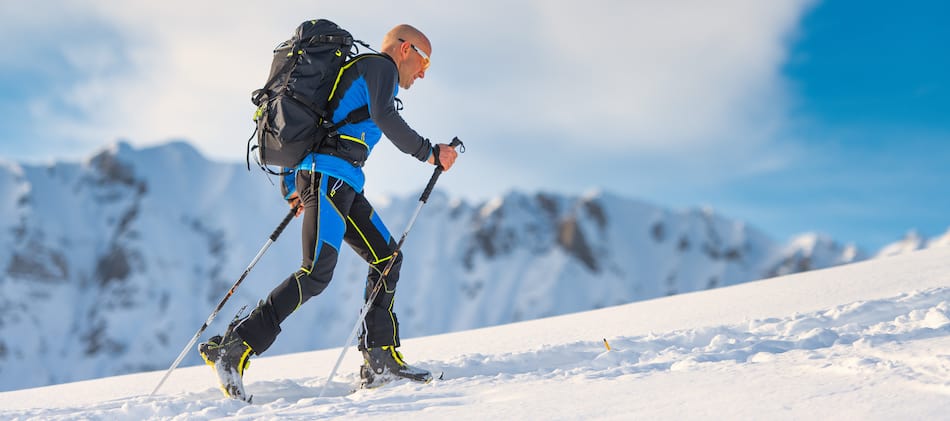
When it’s time to go downhill, you can ‘lock’ the boot and gain back the support you need to properly go skiing.
Furthermore, many alpine touring boots have also made modifications to the sole of the boot to allow for greater grip and freedom of movement. The soles with often be slightly curved, which creates a more natural walking movement. Furthermore, they’ll have ‘lugs’ on the bottom (similar to a hiking boot) that give the boot grip on slippery surfaces.
There are a few different classifications of alpine touring boots. Which boot you will want to buy will depend on what you intend to use it for.
Fast & Light
The fast and light classification of the alpine touring boot takes the ‘hybrid’ design concept and runs with it as far as possible. Which each boot usually weighing in at just over 2 pounds each, they’re built with long traverses or ski mountaineering objectives in mind.
These boots have the most ankle mobility and will be the easiest to walk in. Conversely, that often makes them the hardest to ski in, because they don’t have the same degree of support that a heavier model will provide.
For mountaineering objectives where you’re going to combine ski touring with other activities, such as ice climbing, the light AT models might be for you. If you’re primarily in the sport to shred powder, however, you might want to look for something a little sturdier.
Some examples of fast and light boots:
Arc’teryx Procline
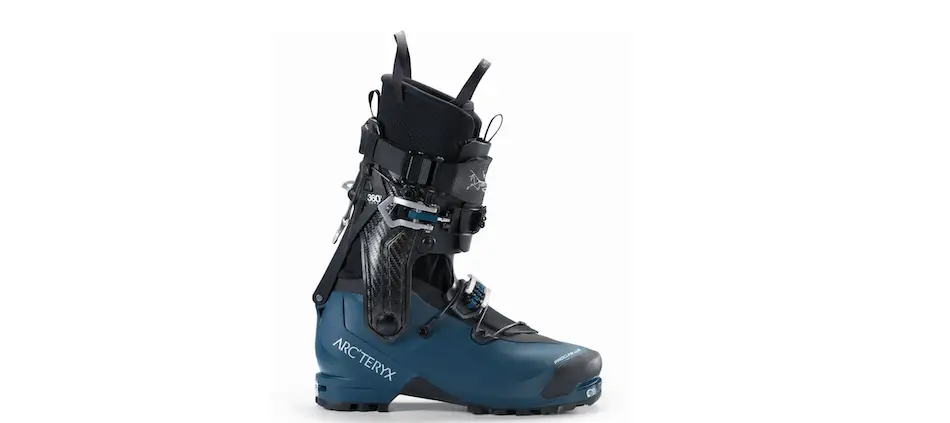
The Procline were a breakthrough boot designed to Arc’teryx, who’s known for making some of the best outdoor gear on the market. Their innovative cuff design allows for 75-degree fore/aft movement, which gives you a pretty normal walking stride. More impressively, the lateral movement of the boot is 35 degrees, which is pretty crazy for a ski boot. This allows you better purchase and traction if you’re trying to move laterally across steep terrain.
Atomic Backland Pro
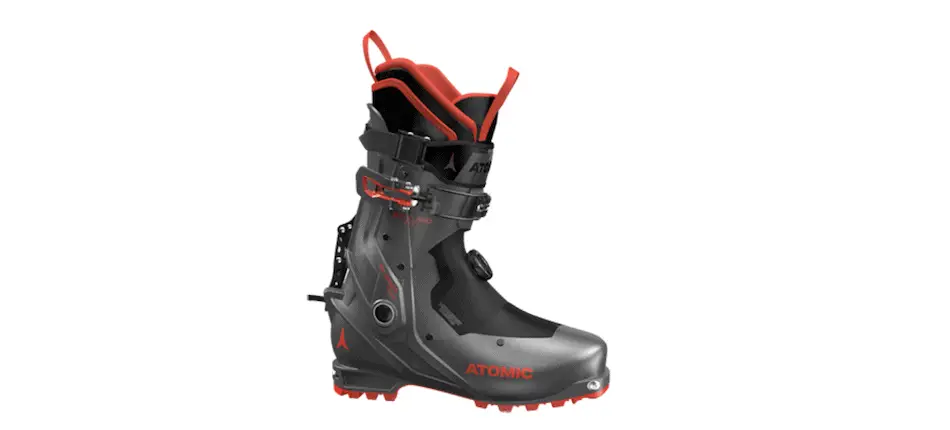
The Atomic Backland Pro are another ultra-lightweight boot that will serve you well on long, multi-activity adventures. The boot comes with a twist-as-you-go dial that allows you to adjust the fit of the boot easily and comfortably, without needing to take your skis off.
Midrange
The midrange boots are the purest form of what an alpine touring boot is meant to be. Designed to be the best boot for backcountry skiing, they combine a good degree of flexibility with enough support to allow to let you carve through even the thickest of powder dumps.
These boots aren’t as comfortable to walk in as the fast-and-light models will be, but there’s still a world of difference between them and traditional skiing boots. The cuff range will be anywhere from 40 to 60 degrees, allowing for a decently normal walking motion. They’ll weigh in at about 1.5 kilo’s per boot, which is a lot of weight to be adding if you’re going to be going on multi-day touring missions.
Not everyone wants boots for that purpose, though. Midrange boots are perfect for purist back country skiers. They have enough mobility to make the walking more comfortable, but when you lock them into position and drop your line, they’re going to be secure and heavy enough to allow you to ski as aggressively as you want.
Some midrange boots include:
Rossignol Alltrack
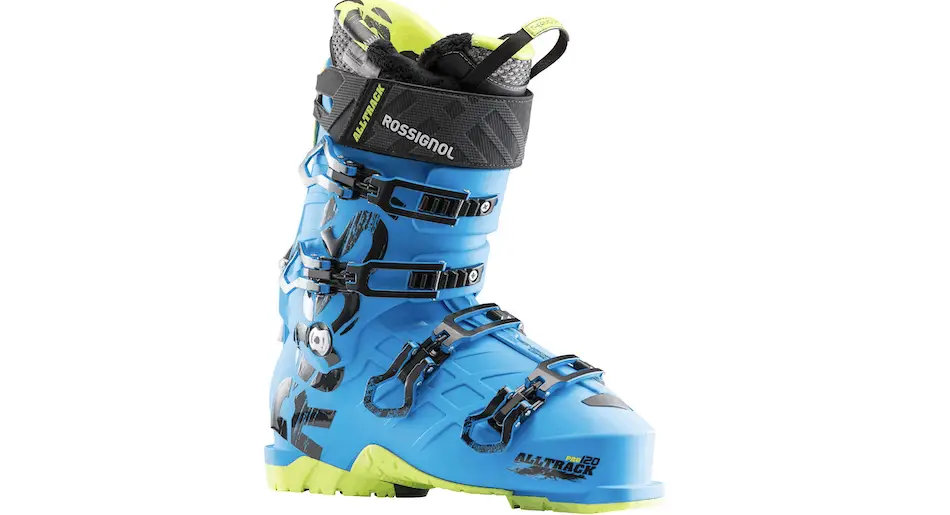
The Rossi Alltracks are a quality boot from one of the most famed skiing manufacturers. Although Rossignol is known for their resort skiing equipment, the Alltrack’s prove that they can made some pretty solid backcountry gear too. With a 50-degree range of motion, lower axis of rotation, and 1.5 kilos of weight, these boots are perfect for touring purists.
Atomic Hawx Ultra
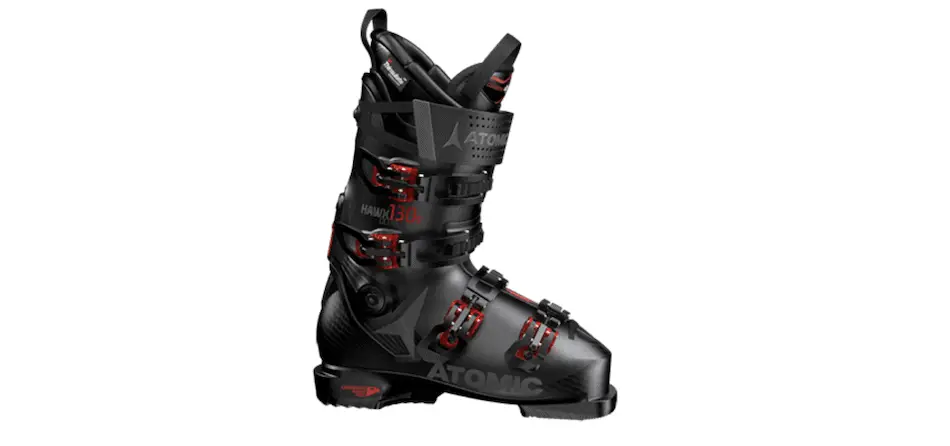
The Atomic Hawx are a classic within the mid-range boot category. With a 55-degree cuff rotation and a new, lightweight design, the boots will serve you well for both the ascent and descent. Furthermore, they have women-specific designs for a better fit and comfort level.
Burly
Weekend warriors, rejoice, because you no longer need to own two pair of boots. With a moderate degree of movement, heavier design, and a more traditional cuff system, the ‘burly’ boot category is built to service you for both lift skiing and backcountry day trips.
If you’re someone who spends most of their time skiing within the bounds of the resort but likes to venture off on the odd backcountry mission, the burly category is perfect for you. With boots in the 1.5-2-kilogram range, these hybrid designs are solid enough for you to rip double blacks and moguls, while still having a walking mode for when you decide to venture off into the unknown.
No one’s going to mistake these boots for cutting-edge mountaineering devices, but for most people, they’re going to do the job perfectly well. They’re light enough for single day touring missions, more comfortably to walk in than a traditional boot, and solid enough to drop even the scariest of lines.
Nordica Strider

The Strider’s are built for anyone who wants to go backcountry skiing but doesn’t want to give up and inch of performance. Solidly built and yet still boasting a 45-degree range of motion, these boots allow you to carve through powder or rip through glades while still being reasonably comfortable on the walk up.
Uses
Now that we know the different classifications of boots, let’s look at some of the different uses that alpine touring boots can fulfill. Although they’re (somewhat obviously) design for ski touring, the boots have expanded from their original purpose and now fulfill the needs of several different niches. Whether you’re carving lines in deep powder or ski mountaineering in Alaska, there’s going to be an alpine touring boot for you.
Ski Touring

For and foremost, and most obviously, there’s ski touring (especially in alpine areas).
When they were first designed, AT boots were meant for this purpose. They were designed to allow you to skin for hours on end across snow-covered terrain, enjoying a good freedom of movement and enough support to find your way back down.
For this purpose, mid-range or lightweight boots are probably the best option. If you tell me that you’re going ski touring, I automatically assume that there’s going to be more ‘touring’ — that is, walking uphill on or across flat terrain— than there will be skiing. In such an instance, comfort, weight, and flexibility are likely more important that how solidly the boot is going to perform on hard lines.
In cases where you need to cover lots of ground on skis, AT boots will definitely be the best choice. They’ll be a whole lot more comfortable than traditional ski boots will be, and they’ll still have the performance required for when you want to get down.
Backcountry Skiing

Drawing the distinction between ski touring and backcountry skiing does seem a little ridiculous, but I’m going to try to do it anyways. For the purposes of this guide, my classifications are as follows:
- Ski touring is akin to backpacking on snow. The main goal of the day is to cover ground and get to a destination. You mostly walk, although some downhill skiing may be required.
- Backcountry skiing is when you try to find the sickest line and be the first one to drop it. The purpose of the walking is to get you in position to hurl yourself down a steep face.
Alpine touring boots can work for either activity, but your buying criteria is going to differ based on what you’re doing.
For back country skiing, support and weight are more important than walking comfort. When you’re carving fresh tracks in Montana or chasing powder in Vermont, you need all the help you can get. I would look at a burly or mid-range boot for this purpose, depending on what type of skiing you’re doing and how much you value comfort.
Ski Mountaineering
For the hardcore and the brave, ski mountaineering was created as a sport. It’s like regular mountaineering, expect you need to carry more weight and you’ll probably end up walking farther (the descent can be a whole lot more fun, though).
Similar to ski touring, ski mountaineering requires a lot of walking, most of it uphill. However, you also need good support in your boots, because you’re going to be dropping some steep lines on the way down.
I would recommend fast-and-light boots for ski mountaineering, because of how versatile and lightweight they are. As the old saying goes, a pound on the foot is worth three on the back, and every gram matters when you’re trying to haul yourself up 14,000-foot mountains.
Furthermore, you’re likely to find yourself on some technical terrain when you do, such as steep snow shoots, ankle-biting traverses, or even rock or ice climbing. In such a situation, having lighter pair of boots that allow for more flexibility could end up being a lifesaver.
Ice Climbing

Ice climbing in ski mountaineering boots can be done either as a standalone activity or as an extension of ski mountaineering.
I’ve written an entire article about ice climbing in ski boots, but it’s still worth it to summarize the main points here. Alpine touring boots are ideal for ice climbing in because they combine the support and protection of a ski boot with some of the sensitivity of a mountaineering boot.
Now, if you’re looking to buy gear specifically for ice climbing— i.e., your plan is to have that as your go-to activity— I wouldn’t recommend picking up a pair of alpine touring boots. Mountaineering boots will still serve you better for this purpose.
However, sometimes you have to do more than just drive to the crag, hop out, and start skiing. If you’re going on a mountaineering mission that will require some sections of ice climbing, or if you simply want to climb a hard-to-reach waterfall and think that skiing will make the approach easier, it helps to be able to wear AT boots for the climbing.
I would definitely recommend fast & light boots for this one. They’ll have the proper balance of flexibility, sensitivity, and support to let you do all the climbing you want while still being able to ski out.
Buying Alpine Touring Boots
Finally, let’s talk a little bit about buying a pair of alpine touring boots. The boots can cost anywhere from $600-$1500, so you want to know what you’re looking for before you head out to the store.
First, there are a few questions you can ask yourself to help you narrow down the search:
- What are you primarily going to be using the boot for?
- Do you need the boot to serve multiple purposes?
- What equipment do you already have? If you own a good pair of ski boots, you might not need a burly pair of AT boots; maybe explore some midrange options instead.
- What shape of foot do you have? Do you know of any brands that typically fit you well?
- What style of bindings will be used with the boot?
Bindings
No guide on alpine touring boots would be complete without a discussion of bindings. Making sure you have the right pair of bindings is essential, or else you won’t be able to clip into your skis.
Not every boot is going to fit every type of binding, which is one of the annoying elements of alpine touring boots. Because of the wide range of designs, weights, and purposes behind the boots, manufacturers sometimes have to get creative with how they design the toe and the heel. Because of this, AT boots aren’t like ski boots, where you can simply click them into any old pair of bindings.
This makes it hard to write a comprehensive guide on the subject, because there are so many boot-specific questions. Your boots might fit with alpine bindings, or they might not. Even if they fit, some manufacturers recommend not using AT boots with alpine bindings, because the increased grip on the sole of the boot makes it impossible for them to release properly. Tech bindings only fit with boots that have a molded-toe and a slot plate at the back.
My advice? Bring your skis or bindings with you when you go to the store and check for fit there. If you find a pair of boots that fit you super well but aren’t compatible with your bindings, it could be worth it to buy a new pair if it gets you the right boots.
